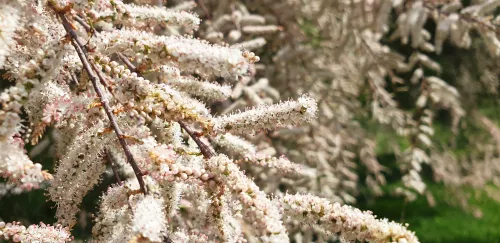A tamarisk does not depend on regular pruning in order for opulent flowering magic to unfold. If you prescribe a pruning of the picturesque ornamental wood, it depends on the right time. Read this guide to learn when and how to perfectly blend spring and summer tamarisk.
 The flowering time of the tamarisk determines the time of pruning
The flowering time of the tamarisk determines the time of pruning
Flowering time dictates pruning time
For imaginative garden design, the magnificent genus of tamarisk gives us spring-flowering and summer-flowering varieties. Spring tamarisks (Tamarix parviflora) shine in their pink-white blossoms from May to June. Summer tamarisks (Tamarix ramosissima) adorn beds and balconies from July until well into autumn with their picturesque clouds of flowers. The respective flowering time determines when you cut the flowering shrub:
- Prune spring tamarisk after flowering
- Prune summer tamarisk in February/March
It is characteristic of the spring tamarisk that it already creates its flower buds in the previous year. If the ornamental tree is cut in late winter, almost all the buds fall victim to the scissors and the longed-for blossom magic fails. The summer tamarisk, on the other hand, is taking its time with the budding until the beginning of this year's season, so you can save the date for a February/March pruning.
Optionally cut tamarisk - instructions
Annual pruning is not mandatory for the pink and white blooms of a tamarisk tree to transform the garden into a fairyland. It depends on your gardening judgment whether you thin out the flowering shrub or cut it into shape. Good to know for beginners in pruning is that thanks to good-natured pruning tolerance and rapid growth rate, one or the other beginner's mistake can be corrected by a tamarisk in no time at all. The following pruning has proven itself in gardening practice:
- In the first step, cut out dead wood, damaged, bare and cross-growing shoots
- Cut back overly long, drooping branches to the desired length
- Trim wilted flower spikes if necessary
- Cut start 3-5 mm above a bud or pair of leaves
In terms of continuous regeneration, we recommend cutting off one or two of the oldest shoots at the base after the fifth year. As a replacement, select the most promising candidates among young ground shoots. Cut off all other shoots at ground level so that the tamarisk can grow loosely and flooded with light. If there is enough space in the bed or tub, the flowering shrub is very well positioned with a framework of five to twelve lower shoots.
Use clippings as cuttings
In the cuttings of a tamarisk there are numerous candidates for propagation by cuttings. Choose 6-inch, semi-lignified shoot tips with no flower buds. Therein lies the potential for another tamarisk tree for creative garden design. Defoliate the bottom half of a cutting and plant it in a pot of rich, well-drained soil.
tips
With a growth height of up to 5 meters, a tamarisk is the perfect house tree. In order to train the pretty flowering shrub to a standard, the time window is open from October to March. The strongest ground drive is chosen as the trunk. Below the desired base of the crown, saw off all side branches to the astring.